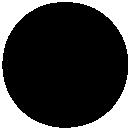




















Aligned with NEP 2020

This book is intended for educa onal purposes only. The informa on contained herein is provided on an “as-is” and “as-available” basis without any representa ons or warran es, express or implied. The authors (including any affiliated organiza ons) and publishers make no representa ons or warran es in rela on to the accuracy, completeness, or suitability of the informa on contained in this book for any purpose.
The authors (including any affiliated organiza ons) and publishers of the book have made reasonable efforts to ensure the accuracy and completeness of the content and informa on contained in this book. However, the authors (including any affiliated organiza ons) and publishers make no warran es or representa ons regarding the accuracy, completeness, or suitability for any purpose of the informa on contained in this book, including without limita on, any implied warran es of merchantability and fitness for a par cular purpose, and non-infringement. The authors (including any affiliated organiza ons) and publishers disclaim any liability or responsibility for any errors, omissions, or inaccuracies in the content or informa on provided in this book.
This book does not cons tute legal, professional, or academic advice, and readers are encouraged to seek appropriate professional and academic advice before making any decisions based on the informa on contained in this book. The authors (including any affiliated organiza ons) and publishers disclaim any liability or responsibility for any decisions made based on the informa on provided in this book.
The authors (including any affiliated organiza ons) and publishers disclaim any and all liability, loss, or risk incurred as a consequence, directly or indirectly, of the use and/or applica on of any of the contents or informa on contained in this book. The inclusion of any references or links to external sources does not imply endorsement or valida on by the authors (including any affiliated organiza ons) and publishers of the same.
All trademarks, service marks, trade names, and product names men oned in this book are the property of their respec ve owners and are used for iden fica on purposes only.
No part of this publica on may be reproduced, stored, or transmi ed in any form or by any means, including without limita on, electronic, mechanical, photocopying, recording, or otherwise, without the prior wri en permission of the authors (including any affiliated organiza ons) and publishers.
The authors (including any affiliated organiza ons) and publishers shall make commercially reasonable efforts to rec fy any errors or omissions in the future edi ons of the book that may be brought to their no ce from me to me.
Subject to Hyderabad jurisdic on only.
Copyright © 2024 Rankguru Technology Solu ons Private Limited. All rights reserved.
ISBN 978-81-967554-4-7
First Edi on
Dear Parents, Educators, and Guardians,
In the ever-evolving landscape of educa on, the Na onal Educa on Policy (NEP) 2020 is a pivotal milestone, emphasizing the cri cal role of ages 3 to 6 in shaping a child’s mental facul es. Moving away from the tradi onal method of memoriza on, it highlights the significance of key learning goals, places a greater emphasis on mul disciplinary educa on, and aims to nurture the crea ve talents of every learner.
Aligned with the visionary NEP 2020, we proudly introduce the “HeadStart Programme” by Infinity Learn— an innova ve educa onal ini a ve me culously designed to for fy your child’s founda on during their most forma ve years. Tailored for Grades 1 to 5, this program aims to ins l a passion for learning and establishes a formidable academic base.
The HeadStart Program unfolds a tailored educa onal experience, commencing with Grades 1 and 2, where the focus lies on making numbers (Math) comprehensible and fostering exploratory learning in Environmental Studies (EVS). Progressing into Grades 3, 4, and 5, the program expands to encompass cri cal mathema cal thinking, explora on of Science, and a nuanced understanding of society, environment, and global ci zenship in Social Studies.
Equipped with though ully cra ed course books, home reinforcement workbooks, and a cu ng-edge learning app, the HeadStart Program leverages both tradi onal and digital tools to ensure a comprehensive educa onal experience.
What is the HeadStart Advantage?
We firmly believe that enhancing crea vity, logical and cri cal thinking in the early years will pave the way for a robust founda on in Mathema cs and Science during the middle years. This, in turn, posi ons learners for success in senior-grade challenges, differen a ng them in high-stakes exams such as JEE, NEET, and CUET.
For educators, we provide me culously designed lesson plans and in-class videos, ensuring uniform and effec ve teaching methodologies. Our mission encapsulates the ques on ‘Baccha Seekha ki Nahi’—did the child learn?—as we are dedicated to ensuring that each child’s learning journey is not merely a progression but a meaningful and enriching experience.
We invite you to join us in this exci ng new chapter of your child’s educa on. The “HeadStart Programme” is more than a curriculum; it’s a pathway to nurturing a lifelong passion for learning. Let’s provide our children with the op mal start in their educa onal journey.
Warm regards,
The Infinity Learn Team

My Study Plan
• Understand positional words: inside and outside, on and under, near and far, above and below, top and bottom, etc.
• Know about sorting objects.
Let’s Recall
Look at the given pictures and tick ( ) the correct word given in the box.










1. The red pencil is longer/shorter than the yellow pencil.
2. The elephant is smaller/bigger than the rabbit.
3. The bucket has more/less water than the glass.
The lion is inside the cage.


There are fish inside the tank.








The monkey is outside the cage.
The shell is outside the tank.
Look at the given pictures. Write I for the ones that are inside and O for the ones that are outside. Let’s Practise - 1








The books are on the table.

The cat is under the table.

1. Tick ( ) the object on the bridge and colour the object under the bridge. Let’s Practise - 2


2. Look at the picture closely and complete the sentences given below.



a. The aeroplane and the birds are flying ____________ Pihu.
b. The birds are flying ___________the clouds.
c. The birds are ____the aeroplane.

Let us now explore four special words: near, far, top, and bottom.
The butterfly is near the flowers. The bumblebee is far from the flower.



Fill in the blank using the suitable word. The school is ________ our house. So, Raju can walk there in a few minutes. (near/far)

The yellow book is at the top of the pile. The blue book is at the bottom of the pile.
Fill in the blank using the suitable word. The star shines brightly at the _____________ of the Christmas tree. (top/bottom)


Let’s Practise - 3

1. Look at the picture given below and fill in the blanks using ‘top’ or ‘bottom’.



a) The red flag is at the ____________ of the lighthouse.
b) The car is at the __________of the lighthouse.
2. Look at the picture below and complete the sentences with ‘near’ or ‘far’.


a) Pihu is __________ the well.

b) The girl wearing a pink dress is _________ from the well.

More-Less
Aayu drinks more water.
Pihu drinks less water.


Write M (more) and L (less) for the objects in each set given below. a.b.



Sorting is like putting similar things together. Sometimes, we find one that is different from the others—it is the odd one out! Like grouping animals and a flower—the flower is the odd one because it is not an animal.
Circle the picture that does not belong to the set. One has been done for you.


• Words like ‘inside,’ ‘outside,’ ‘on,’ ‘under,’ etc. help us describe where objects are placed.
• Sorting objects means putting similar things together and finding the one that is different from the rest. This helps us learn how things are similar or different. We should protect wild animals. They need our love and care.
Science:
Science is all about curiosity and exploration, and today, we’re going to dive into an exciting experiment involving water! Get ready to discover which objects float and which ones sink, and to learn about what’s on top and what’s at the bottom.
Experiment:
Fill a container (like a bowl or a glass) with water.

Gather a variety of objects from around your house, such as a plastic toy, a coin, a piece of paper, and a small rock.
Questions to Explore:
Which of these objects float? Which ones sink?
Take each object one by one and gently place it in the water.
Observe what happens. Does the object stay on the surface (float) or go to the bottom (sink)?
What remains on top and what settles at the bottom?
Once you have tested all the objects, think about what you have discovered.
Why do you think some objects float while others sink?
Activity: Position Hunt
Materials Needed: A small toy
Instructions:
1. Choose a position word from the list.
2. Place your toy according to the position word.
3. Describe where you have placed the toy to your friend or family member using the position word.
Ex : My toy is below the table.
4. Repeat the activity with more position words. This fun activity helps you understand how things can be in different places or positions.
Let’s perform a group activity!
Position-Pihu Says!
Instructions:
1. Select one student as Pihu.
2. Pihu gives simple position commands.
Ex : Pihu says raise your hands above your head. Pihu says stand behind a chair.
3. Other students should only follow when ‘Pihu says’ is used in the instruction. If ‘Pihu says’ is not used, they should stay still.
The last student who does not make a mistake becomes the next Pihu.
There are four main directions: East, West, North, and South.
Now, answer the following question:
You are moving in the East direction. After moving some distance, you take a left and then a right. In what direction are you moving now?
Tip for the Parent
Engage your child in everyday activities that involve positions. For example, setting the table, arranging toys, or playing games. Use a simple and clear language to explain position words such as ‘on’, ‘above’, ‘below’, and ‘behind’.
My Study Plan
• Different shapes around us
• Names of the flat shapes
• Classifying similar shapes
• Rolling and sliding objects
• Drawing shapes
• Different patterns of shapes
Let’s Recall
Look at the objects given below. Draw arrows to put the long objects in the green basket and the round objects in the red basket.









Find objects with various shapes in your surroundings. Write their names under long objects and round objects.

Match the objects that are similar in shape:














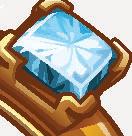



















Shapes like these are called solid shapes.












There are also some shapes which are called flat shapes. Here are some examples of flat shapes:
- Piece of paper
- Tortilla
- Building block
We can classify the flat objects into two categories:
a) Flat shapes that have sides and corners.

b) Flat shapes that are round.
To identify these shapes, you need to look at their sides and corners.
A triangle has three sides and three corners.
A square has four equal sides and four corners.

A rectangle has two long sides and two short sides with four corners.
A circle has no corners, and has a round shape.




An oval is egg-shaped flat surface that has no corners.
We can use shapes to create different pictures and designs.
Look, Rohan used different shapes to create this picture. Try to make a picture using different Flat Shapes.
Zone
A semicircle is one half of a circle.


Let’s Practise - 1
1. Match the objects with their shapes:



















2. Tick the shape which is similar to a ball. ✓








3. Tick the shape which is similar to a cap. ✓

















4. Tick the shape which is similar to a glass. ✓

5. Tick the shape which is similar to a matchbox. ✓

















A shape that has five sides and five corners is called a pentagon.
1. Count the number of triangles in the given figure.
Let’s Practise - 2 Picture-1Picture-2
2. Match the objects given in Picture -1 with the shapes given in Picture -2. Colour each object in Picture -1 with the colour of the shape it matches.

Some solid shapes roll, while some slide. Here is an easy way to find which objects roll and which objects slide.
• Generally, objects with sides and corners cannot roll, but they can slide.
• Objects that are round can easily roll.
Look at the examples below:
There is a slide and a ball is pushed down from the top. As the ball is round, it rolls.
Then, a pencil box is pushed down. As the pencil box is not round, it slides.
Let’s Practise - 3
1. Look at these pictures. Write ‘R’ for the objects that will roll and ‘S’ for the objects that will slide.










2. What will we use to strike down all the pins?














3. Look at the picture given below and answer the following questions:
a. How many squares can you see in this picture?
b. How many circles can you see in this picture?
c. How many triangles can you see in this picture?
d. How many rectangles can you see in this picture?
Let’s Practise - 4
Draw a picture using flat shapes. Colour the circles in red, the squares in green, the rectangles in yellow and the triangles in brown.
Let’s Sum Up
• Circle: Round shape
• Square: Four equal sides and corners
• Rectangle: Two long, two short sides, and corners
• Triangle: Three sides and corners
• Oval: Stretched circle, no corners
Think about how you can use your knowledge of shapes to organise your toy box. Can you arrange your toys by shape, size, or colour? How does organising your toys in this way help you?
Language:
How can you use shapes to describe your favourite cartoon character or object? For example, a round face or a triangular towel.
Social Studies:
Can you think of any buildings that are made of various shapes? List them down.
If you have a square cookie and your friend has a round cookie, how can you share them equally so that both of you get the same amount? 21st Century Skills
3D (three-dimensional) shapes are solid shapes that have three dimensions: length, height and width. 3D shapes are not flat shapes but solid shapes. For example, your toys are not just drawings on paper; they are 3D because you can touch and feel them.
• Use hands-on shape manipulatives for interactive learning.
• Use sorting activities to explore shape characteristics.
• Use visual aids for shape recognition.
My Study Plan
• Counting and writing numbers (0 to 9)
• Understanding zero
• Cardinal numbers: Numerals and Number names
• Comparing quantities (More/Less/Equal)
Look at the picture showing children playing at the beach. Count the number of objects, animals and trees in the scene.





Colour the pictures in the first row and join the dots to make numbers in the second row. Then match these numbers with your answers to check if you have counted correctly or not.
How many different colours do you need to colour a rainbow?

Counting numbers can help us understand what is ‘one more than’. For example: You have 1 toy car and your parents gift you 1 more toy car. So, we can say that now you have 2 toy cars.
Keeping this in mind, let us learn counting from 1 to 9 and their number names. h
Count the number of balloons in each row. Read out all the numbers and their number names loudly. 1 One 2 Two 3 Three 4 Four 5 Five 6 Six 7 Seven 8 Eight 9 Nine Let’s Learn
Zero
Zero is a number which means ‘nothing’. Let us understand number zero with an example:
There are three birds on a tree.
Two birds fly away upon hearing the balloon burst. Now there is only ‘one’ bird left on the tree.
After some time, another bird flies away in search of food.
Now there are ‘no’ birds left on the tree. We can also write ‘no birds’ as ’zero birds’. We use zero (0) to show that there are no birds or objects.
Let’s Practise - 1
Count the number of objects in the room and fill in the blanks below.





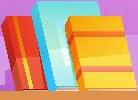

























a. Number of tables__________
c. Number of chairs__________
e. Number of books__________
g.Number of toy cars_________
i .Number of marbles_________
Thinking Zone

b. Number of pencils_________
d. Number of flowers_________
f. Number of balloons________
h. Number of blocks__________
j. Number of dolls ___________
Look at the given figure. Think and write the missing numbers in the spaces provided.
1
5
3
Cardinal numbers can be written as symbols, just like numerals 1, 2, 3 and so on. Cardinal numbers can also be written in words like one, two, three and so on. Practise saying the names of the numbers out loud. 1 One 2 Two 3 Three 4 Four 5 Five 6 Six 7 Seven 8 Eight 9 Nine
Cardinal numbers are sometimes called counting numbers. We use cardinal numbers to answer the question “How many”.
Let’s Practise - 2
Count the number of dots on the top of the dice and fill in the given space below.
Let’s Learn

Can you find out which jar has more pencils and which jar has less pencils?
‘More or less’ helps us compare quantities. ‘More’ means a larger amount, and ‘less’ means a smaller amount.
As we can see, the first jar has 6 pencils and the second jar has 3 pencils.
So, we can say that the first jar has more pencils than the second jar, or the second jar has less pencils than the first jar.
Look at the leaves.
There are 5 green leaves and 4 brown leaves. We have more green leaves and less brown leaves. ‘More’ means a larger number, and ‘less’ means a smaller number.

When both sides have the same number of things, they are equal. For example, here, there are 5 green leaves and 5 brown leaves. So, they are equal, and we can say there are ‘just as many’ of each.

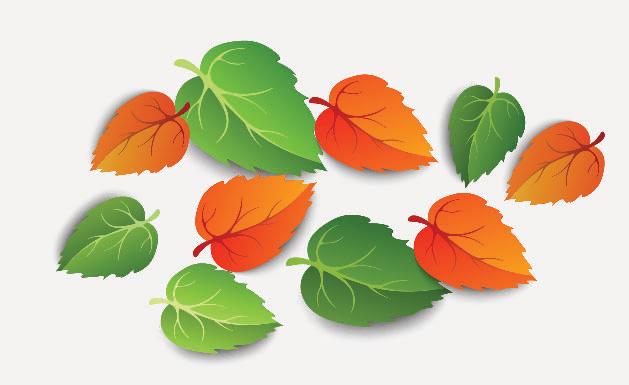
The following picture shows three sets of leaves. Count and write whether the number of green leaves is (more than/less than/equal to) the number of brown leaves. Fill your answer in the space given below.



Aryabhatta, a famous Indian mathematician, invented the number zero. Fact Zone
Numbers help us count things.
Numbers help us know ‘how many’.
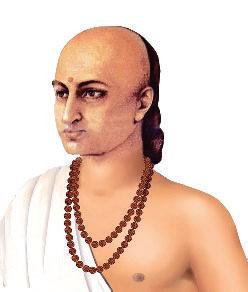
Numbers help us compare two groups of objects. All numbers are made up of numerals from 0–9. Numbers can be written in words, for example, one, two, three, four and so on.
You are planning a picnic with your friends, and you need to make sandwiches for everyone. Each sandwich requires 2 slices of bread.
If you have 6 slices of bread, how many sandwiches can you make for your picnic?
Science:
If an insect has 4 legs, how many legs do 2 insects have in total?
Social Studies:
A student learning about community helpers knows there are 3 police officers in her neighbourhood. If one more joins, how many police officers will there be?
Count the number of lines used to form the given numbers and fill in the blanks: :_________
The number 10 is so special that it is made up of two digits, 1 and 0. When we combine these two digits, we get the number 10. For example: We have 10 fingers on our hands and 10 toes on our feet.
When we count to 10, it goes like this: 1, 2, 3, 4, 5, 6, 7, 8, 9, 10!
• Use everyday items like toys, fruits, or household objects to represent numbers from 0 to 9.
• Engage your child in counting games, sing counting songs, and point out numbers in the environment around them.
• Add numbers using pictures and concrete objects
• Add numbers vertically and horizontally
• Solve real-world problems using addition
Count the total number of buttons in the picture:

Your grandmother gave you 2 lollipops and your grandfather gave you 3 lollipops. How many lollipops do you have in all?
Addition is when we combine numbers together to find out the total number. Let us understand how to do this through an example:
There are three birds in the sky.

Two more birds join them.
Altogether, how many birds are flying now?
How will you find that out?
To find the total number of birds flying now, we count all the birds.
After counting the birds, we find that there are 5 birds flying now.





Let us look at this: and are equal to 3 kites4 kites7 kites and are equal to 1 ball8 balls9 balls



The ancient Egyptians used small stones called ‘pebbles’ to represent numbers. Each pebble represented a specific value, and they would add or combine pebbles to find the total.
1. Answer the questions given below:
a. You have 4 apples and your friend gives you 2 more. How many apples do you have in all?
b. How many are 3 flowers and 2 flowers altogether? Show your answer by drawing the flowers and counting them.
Ancient: Very old
Specific: Something particular Word Zone

Let’s look at the butterflies here. and are equal to 2 Butterflies 1 Butterfly 3 Butterflies altogether
We write it as 2 + 1 = 3.

Imagine you are at number 5 and you jumped 2 steps forward, at which number will you now be?
Can you put the ‘+’ sign and ‘=’ sign at the right places in the following?
Let’s Practise - 2
2 bananas and 4 bananas altogether make ___ bananas.
2 + 4 = +
2 stars and 3 stars altogether make ___ stars.
2 + 3 = +
4 apples and 1 apple altogether make ___ apples.
4 + 1 = +
Horizontal and vertical addition
Add these birds in the picture.
On combining, 1 + 2 = 3 i.e. there are three birds in the picture. This is known as horizontal addition. We can also add the same numbers by writing them vertically as given below.
+2 =3
This is known as vertical addition.
We can also draw pictures of objects and then count them together to find the total number of objects.
Let us solve an addition problem by drawing pictures.
3 + 4 =_______
Draw 3 circles
Draw 4 circles
Now, let us count them together. After counting, we get 7 circles. So, 3 + 4 = 7.
We can count forward to add two numbers.
For example, let us count 2 more than 2.
Keep 2 in your mind.
Then put 2 fingers up.
Now, count forward from the number in your mind, which is 2, so the fingers you are holding up will be counted as 3 and 4.
Thus, 2 + 2 = 4.
The sum of opposite faces of a dice is always 7.
Let’s Practise - 3
Answer the questions below:
1. Count and add the numbers horizontally and vertically.



2. Solve the following problems.

3. Count forward to add the numbers given below.

4. Draw pictures of an object of your choice to add the numbers given below.
3 + 2 = ___
Aayu has 5 books. Pihu has 2 books. How many books do they have altogether? Ones
Aayu has 5 books.5
Pihu has 2 books.+2
Thus, they have 7 books altogether. =7
1. Read the following number stories and solve them.
a. Rajesh has 2 pens. Renu has 4 pens. They have ……..+…………=……….pens in total.
b. Mahi has 3 toffees. Her sister gave her 4 more toffees. She has ……..+…………=………. toffees in total.
• In order to know how many objects/things we have in total, we need to add them.
• We can add by drawing pictures, by counting forward, or by solving number stories.
You have 3 apples, and your friend gives you 5 more apples. How many apples do you have in total? Can you show two different ways to find the sum?
A farmer has 3 cows in one field and 1 more cow in another field. How many cows does the farmer have in total? Use addition to find the answer and talk about the role of farmers and the importance of livestock in a community.
You have 1 hour of playtime in the morning and then get 2 more hours in the afternoon. How many hours of playtime do you have in total? Use addition to find the answer and discuss how to make the best use of your time between different activities.
You are planning a picnic, and you want to bring some snacks. If you pack 24 grapes in one box and 16 strawberries in another, how many fruits do you have in total?
• Use everyday objects and visuals to explain addition.
• Create real-life word problems for practical understanding.
My Study Plan
• Taking away
• Using symbols
• Subtraction using number line
• Backward counting
• Subtracting numbers
• Solving subtraction problems
Let’s Recall
Look at the picture and solve the problem.















There were 8 birds on a tree. 3 birds flew away. Now there are ___________ birds left on the tree.
You got six roses for your birthday. Two of them dried up. How many roses are still fresh? Talk to your partner about how you found out the number of fresh roses.



Aayu and Pihu are good friends. They love to play with their toys. Let’s see what they are doing.



Pihu is building a tower with her blocks. She made a tower with 5 blocks. But, Aayu’s ball knocked down 2 blocks. Now, Pihu’s tower has 3 blocks left.









Look at the above images and answer the questions given below: Like Pihu, Aayu makes a stack of ____ books. He gives away _____ books to his friend.
Now, Aayu is left with _____books.
When we ‘take away’ or ‘give away’ some objects from a group of objects, we call it subtraction.
Stack: Putting things one on top of another, like a tower of blocks
When we want to ‘take away’ something, we use the minus symbol (–). The equal to (=) sign is used to show the result or answer.
Let’s learn how to use these symbols with some examples:
Mr. Baker had 7 cupcakes on a plate. He gave away 2 cupcakes to his friends. How many cupcakes does he have left?
We can use the minus (–) sign to show ‘take away’.
We take away the smaller number from the bigger number. So, take away 2 from 7.
7 – 2 = 5
Therefore, Mr. Baker has 5 cupcakes left.
Look at the sky filled with colourful kites. Fill in the blanks to show what happened using subtraction.





















In a tray of 9 eggs, 4 eggs are broken. We can cross them out. And count the remaining eggs.




So, take away 4 from 9.
4 =
After removing the broken eggs, there are 5 good eggs left in the tray.
Fact Zone
Words that help us know when we are subtracting in a word problem: take away, minus, less, difference, subtract.
Let’s Practise - 1
1. Cross out, count, and write.
Take away 4 from 7. 7 – 4 =
2. Write the symbol ‘– ‘ or ‘=’ to fill in the blanks.
Look at the friendly frog on the number line. The frog hopped and landed on number 8.

012345678910111213141516
Guess where will it be if it jumps back five numbers on the number line?

012345678910111213141516
To subtract on a number line, we start at a certain number and move backwards to find the answer. Hence, 8 - 5 = ____________.
Let’s Practise - 2
1. Look at the image below and fill in the blanks.

Backward counting means to count back from a given number. To subtract 4 from 8, start from 8 and count back by 4 numbers: 7, 6, 5, 4.
Therefore, 8 – 4 = 4.
In a basket, there are 6 juicy oranges. 4 of them are taken away. How many oranges are left?
We can represent the above subtraction as:
This is an example of horizontal subtraction. We can also write this as: This is known as vertical subtraction.
Aayu has 7 candies. He gave 3 candies to Pihu. How many candies does Aayu have left?
Practise - 3


















b. Rajat bought 9 oranges. 2 oranges are rotten. Rajat has_______oranges now.
c. There are 4 dogs in the park. 2 dogs went away. There are _______dogs now.





1. Solve the following number stories: a. Rashi had 8 bananas. She gave 4 to her younger brother. She has______bananas now.












Subtracting zero from any number doesn’t change the number.






When we ‘take away’ or ‘give away’ some objects from a group of objects, we call it subtraction.
Minus is written as ‘– ‘. It is a sign for subtracting. A ‘– ‘ sign means that we are taking away or subtracting.
You have 6 slices of bread. You use 2 slices of bread to make a sandwich. How many slices of bread are you left with?
Arts:
In a garden, there are 5 flowers which are red and yellow in colour. If 3 of them are red, then find out how many are yellow in colour? Draw the flowers and show the subtraction in the box below.
English:
You have a basket with 4 different fruits. If you take away 1, how many fruits remain in the basket? Write down the names of the remaining fruits.














You have 10 toy cars and you gave 2 toy cars to your friend. How many toy cars do you have now?
Calculate the result by using the number line given below.
When we subtract one from a number, we get the number just before the given number.
• Use the real-life situations like sharing toys, candies etc. to make children understand the concept of subtraction.
My Study Plan
•Numbersupto20
•Numbersupto20inwords
•Numbersastensandonesbypictorialsandnumerals
•Differentgroupsofsimilartypesofobjects
•Numberlinetorepresentnumbersupto20
•Comparingnumbersupto20
Look at the picture below and answer the questions.
1. How many people do you see?
2. How many boys do you see?
3. How many girls do you see?
How many chocolates do you have in total? Thinking Zone

Look at the pencils Pihu got on her birthday.
Count and write the number of pencils: __________
Do you know what comes after 9?
Yes, 9 and 1 more is 10.
This is how we can make a group of 10 pencils.

Now, do you know what comes after 10?
Yes, 10 and 1 more is 11. Let us learn about some numbers and their names.
When we express numbers in words, we call them number names. Example: 10 is written as ‘ten’ in words; 11 is written as ‘eleven’ in words.
as group of 10
Count the number of pencils given below. Start with 10 and open one finger each for loose pencils. Also, read out aloud the number names by spelling them.
A bundle of ten pencils is 10Ten
One bundle of ten pencils and one loose pencil is 11Eleven
One bundle of ten pencils and two loose pencils is 12Twelve
One bundle of ten pencils and three loose pencils is 13Thirteen
One bundle of ten pencils and four loose pencils is 14Fourteen
One bundle of ten pencils and five loose pencils is 15Fifteen
One bundle of ten pencils and six loose pencils is 16Sixteen
One bundle of ten pencils and seven loose pencils is 17Seventeen
One bundle of ten pencils and eight loose pencils is 18Eighteen
One bundle of ten pencils and nine loose pencils is 19Nineteen
Two bundles of ten are 20Twenty












We know that 10 and 1 more give us 11. Let us try a different way to get to 11, how about 9 and 2 more.
Example: Count the objects below to check how same number of objects can be arranged in different ways.















































































The number 11 looks like two little ones standing together. It’s called a ‘double-digit’ number, and it’s bigger than all the single-digit numbers!
Let’s Practise - 1
1. Count the objects. Write the number and the number name for the number of objects in each row.

2. Complete the sequence.
Look at this number line. It shows all the numbers from 0 to 20.
When the numbers are arranged from the smallest to the greatest such as 0, 1, 2, 3, … 15, … 20, we say, they are arranged in an ascending order of numbers on the number line. This is how we compare numbers and find out which number is greater or smaller than the other.
When you look at the above numbers on the line from left to right, you are going from the smaller ones to the larger ones. Here are some examples of numbers arranged in ascending order:
• 4, 6, 8, 10
• 12, 14, 15, 18
• 14, 15, 16, 18
Now, look at the number line given below and try to answer the following questions: 1 0 23 4
Compare: To find similarities or differences in two or more things. Word Zone
1. 14 is____ than 5. (greater/smaller)
2. Circle the number which is smaller.
When the numbers are arranged from the greatest to the smallest, such as 20, 19, 18, 17…….0, we say that they are arranged in a descending order.
Descending order
1 0 23 4 567 8 910 11 12 1314 15 16 17 1819 20
When you look at the above numbers on the line from right to left, you are going from the larger ones to the smaller ones.
Here are some examples of numbers arranged in descending order:
• 16, 15, 14, 13
• 14, 12, 10, 7
• 12, 11, 8, 5
Now, look at the number line given below and try to answer the following questions:
1 0234567891011121314151617181920
• 18 is____ than 15. (greater/smaller)
• Circle the number which is greater. 13, 17 15, 10 10, 20 4, 3
• 9 is the greatest one digit number.
• 10 is the smallest two digit number. Fact Zone
1. Write the numbers 13, 14, 12, 3, 31, 16 in ascending order and descending order.
2. Find and circle the following numbers on the number line: 11, 14, 18, 19.
1 0234567891011121314151617181920
You have 2 packs of chocolates, each containing 6 chocolates. How many chocolates do you have in total? Thinking Zone

• Numbers from 10 to 20 can be formed by grouping in different ways. For ex: 10 and 1 more gives 12. 9 and 3 more also gives 12.
• When we arrange numbers from smallest to greatest, it is called ascending order.
• When we arrange numbers from greatest to smallest, it is called descending order.
Drawing: Connect the dots in ascending order of numbers, and when you reach the end, draw a line between the dots numbered 20 and 11 to reveal the hidden shape.
English: Find the total number of words used in the given poem.
“In a garden, oh so bright, A butterfly takes its flight. With wings of blue, green, and gold.”

Draw a number line from 1 to 20. On this line, a frog named, Hank, is at the number 3. Hank jumps forward 6 times, leaving 1 number each time.
On the number line, Hank is at which number?
In a parking lot, we can park 7 cars in each row. How many rows will we need to park 21 cars? Draw your own parking lot.
Encourage your child to count everything they see. This could be the number of birds in the sky, cars on the road, count the objects or fruits, or items in a shopping cart.
My Study Plan
Addition by making bundles of tens and ones
Addition by counting forward
Properties of addition
Addition of 3 one-digit numbers
Subtraction by counting backwards
Subtraction by comparing numbers
Horizontal and vertical addition and subtraction
Solving story problems on addition and subtraction
Let’sRecall
1. Add the number of apples and write the sum in the given box.

2. Count the blocks and fill in the blanks with the correct number and its name.

NumberNumber Name


Imagine you have 13 footballs. Your teacher has asked you to find different ways to group 13 footballs into two groups so that when you count the groups together, the total is still 13. For example, one way can be 5 + 8.




























Addition is the process of combining two or more numbers to find their total.
Let us learn different ways of adding two numbers.
Addition by making bundles of tens and ones
Addition by making bundles of tens and ones means changing of one number in the problem to number 10. This makes the calculation easy.
Example: 7 + 8 = _____
Solution:
Let us make two tables of 10 boxes each.
We will draw 7 circles in the first table and 8 circles in the second table.
Now, how many more circles do we need in the first table to make it 10?
We need 3 more circles to make it 10. So, we will take 3 circles from the second table. 10 5
Now we have 1 ten and 5 ones which makes it 15.
So, 7 + 8 = 15
Let’s Practise - 1
1. Add the numbers by making bundles of tens and ones.
a. 9 + 5 =______
b. 7 + 6 = ________
Now we will learn how to add two numbers without drawing any pictures. It will help us solve the problem quickly.
Counting forward means saying the next number.
For example, if we want to add 12 and 4, we will start saying the next number either from 12 or 4. If we count from 12, we say the next 4 numbers, and if we count from 4, we say the next 12 numbers.
Aayu and Pihu started counting in different ways.
did Aayu count?

numbers after 4









































































































numbers after 12





























Both got the same answer and both are right. But whose addition was quicker?
Yes, Pihu’s addition was quicker.
So, while counting forward, we should start from the bigger number out of the two.
Example: Add 14 and 5 by counting forward.
Solution: Keep 14 in mind and say the next 5 numbers.





So, 14 + 5 = 19
Let’s Practise - 2
1. Add the numbers by counting forward.
a. 12 + 3 = ______
b. 14 + 4 = ______
c. 11 + 2 = ______
d. 13 + 6 = ______
1. Addition of one (1)
When one (1) is added to a number, we get the next number as the answer.

2. Addition of zero (0)


When zero (0) is added to a number, the answer is the number itself.




3. Order in addition




If the order of the number being added is changed, the answer will remain the same.









Let’s Practise - 3
1. Complete the following additions.
a. 4 + 0 =

b. 3 + 1 =

c. 2 + 7 = + 2

d. 7 + = 7

e. 4 + = 5

Let’s Learn
Let us consider a situation,


There are 4 rats playing.



2 more rats join them
4 + 2 = 6



There are 6 rats playing now.




3 more rats join them




6 + 3 = 9

There are 9 rats altogether now.









To add three numbers, first add the first two numbers. Then, add their sum to the third number.
We can also add the last two numbers first and then add their sum to the first number.








Let’s Practise - 4
1. Add three one-digit numbers.
a. 4 + 3 + 2 = ______
b. 2 + 4 + 1 = ______
c. 1 + 3 + 2 = ______
d. 5 + 2 + 1 = ______


Taking away a number from another number is called subtraction.
‘–’ (minus) is the sign used for subtraction.
Example:
If you have 10 marbles, and you take away 3, you can write it as 10 - 3 = 7.


























































1. Subtraction by counting backwards
Example:
So, 18 – 5 = 13 5 4 3 2





Now, we will learn two ways of subtracting numbers.




We can subtract numbers by counting backwards. Counting backwards refers to starting from a big number and saying the numbers in backward order.
If we have to subtract 5 from 18, then we say 5 numbers from 18 in backward order. It will be: 17, 16, 15, 14, and 13.
Subtraction by comparison means finding the difference between two numbers. We look at how much greater one number is than the other.
Example:
Aayu has 16 pencils and Pihu has 12 pencils. How many more pencils does Aayu have than Pihu?
Solution:
Step 1: Represent Aayu's 16 pencils in terms of tens and ones.
Step 2: Represent Pihu's 12 pencils in terms of tens and ones.
Step 3: Cancel the same objects to find how many more.

Hence, Aayu has 4 more pencils than Pihu.
Let’s Practise - 5
1. Subtract by counting backwards.
a. 16 – 5 = ____
b. 14 – 6 = ____
c. 19 – 5 = ____
2. Solve by comparison.
a. Jimmy has 8 marbles. Her friend Jitu has 5 marbles. Find out who has more marbles. How many more does the person have?
b. Seema has 8 candies. Her sister Veena has 13 candies. Find out who has more candies. How many more does she have?
Let’s Learn
Horizontal and Vertical Addition
Horizontal addition

When we write two numbers side by side and add them, it is known as horizontal addition.
Example: 5 + 7 = 12
Vertical addition
When we write two numbers one below the other and add them, it is known as vertical addition.
Example: Add 12 and 6.
Solution:
Step 1: Arrange the digits in the table with bigger number written first.
Step 2: Add the digits in ones place.
2 ones + 6 ones = 8 ones
Step 3: Add the digits in tens place.
1 tens + 0 tens = 1 ten
Horizontal and Vertical Subtraction
Horizontal subtraction
When we write two numbers side by side and subtract them, it is known as horizontal subtraction.
Example: 19 – 7 = 12
Vertical subtraction
When we write two numbers below each other and subtract them, it is known as vertical subtraction.
Example:
Subtract 4 from 17
Step 1: Arrange the digits in the table with the bigger number written first.
Step 2: Subtract the digits in ones place.
ones – 4 ones = 3
Step 3: Subtract the digits in tens place.
2.
'Solving Story Problems' means reading a math story, understanding what the question is asking, using math to find the answer, and checking if the answer makes sense.
Example 1:
There are 19 birds on a tree. 4 fly away. How many birds are left on the tree?
Here, the birds 'fly away'. Hence, we will use subtraction. We will use words, numbers, and symbols to calculate and find the answer.





Solution:
Number of birds on the tree = 19
Number of birds flew away = 4
Number of birds left = 19 – 4
We will use vertical subtraction method to find the answer.
Step 1: Subtract the digits in ones column.
Step 2: Subtract the digits in tens column.
Example 2:
There are 14 birds on a tree. 4 more sit on it. How many birds are there in total on the tree?
Here, 4 more birds sit on the tree. Hence, we will use addition. We will use words, numbers, and symbols to calculate and find the answer.





Solution:
Number of birds on the tree = 14
Number of birds come = 4
Total number of birds on the tree = 14 + 4
We will use vertical addition method to find the answer.
Step 1: Add the digits in ones place
Step 2: Add the digits in tens place
Imagine numbers as magical friends. If we add a number to another number and then subtract the second number from the sum, we get the first number.
Let’s Practise - 7


For example, 5 + 3 = 8

8 – 3 = 5 5 +

1. Remi has 15 stickers. She gives 6 stickers to her little brother. How many stickers does Remi have now?
2. Sonu has 18 toy cars. He buys 2 more cars at the store. How many toy cars does Sonu have now?
• Addition is the process of combining two or more numbers to find their total.
• If the order of the numbers being added is changed, the answer will remain the same.
• To add three numbers, first add the first two numbers. Then, add their sum to the third number. We can also add the last two numbers first and add their sum to the first number.
• Taking away a number from another number is called subtraction.
• ‘–’ minus is the sign used for subtraction.
• Subtraction is when we take one number away from another. To do this, we have different methods: Counting backwards, Using horizontal and vertical ways, and Comparing numbers.
If you start doing 10 jumping jacks and then do 5 more, how many jumping jacks will you do in total?

Find things around your home (toys, books, cups). Write down prices or make up prices for each thing. Pick any three objects and add their prices. Then, pick one of the three objects and take its price away from the total. Share what you found out about adding and taking away prices!
Work in pairs to solve this riddle and give a step-by-step explanation for it. My ones digit is 2 + 6. My tens digit is 1 – 0. Who am I?
Adding zero to a number or subtracting zero from a number does not change the number! Adding 0 to any number keeps it the same (Example: 5 + 0 = 5). Also, subtracting 0 from a number leaves it unchanged (Example: 9 – 0 = 9).
Use objects and visuals to help your child understand addition and subtraction in real-life situations.
Counting numbers from 21 to 50
Counting backwards and forward
Number line to represent numbers up to 50
Comparison of numbers
Order of numbers
1. Count the number of fruits and write the number in the box. a.



Here is a number line that shows numbers starting from 1. When we move one place to the right, we go to the next number. So, if you are standing at 19 and move two places to the right, what number will you reach?




































123456789101112131415161819
Here are 15 bananas.
How many tens and ones are there in 15? = and 1 ten5 ones
15 has 1 ten and 5 ones.
Here are 20 bananas, and 20 has 2 tens in it.




What will happen if we have 1 more banana?
We will have 20 bananas and 1 more banana. We read it as twenty-one.
Now, complete the table given below:
21
Twenty-one
TensOnes
21
TensOnes
22 Twenty-two
TensOnes
TensOnes
TensOnes
TensOnes
TensOnes
TensOnes
TensOnes
TensOnes





















TensOnes
























TensOnes
TensOnes
TensOnes
TensOnes
There are special names for some numbers.
• One dozen represents 12 objects/items.
• In cricket, when a player scores 50 runs, it is called a half-century.












































1. Count the objects in each set. Write the number and the number name in the given space. TensOnes Number: Number Name: __________




























































2. Write the missing numbers.
Counting Backwards means to move back or count in the opposite direction, from a higher number to a lower number or from the end to the beginning.
For example:
• Count backwards from 10 to 1: 10, 9, 8, 7, 6, 5, 4, 3, 2, 1
• Μοvebackwards three steps from number 10.




















For example:









Counting Forward means to move ahead or count in the regular direction, from a lower number to a higher number or from the beginning to the end.
• Count forward from 1 to 10: 1, 2, 3, 4, 5, 6, 7, 8, 9, 10
• Move forward five steps from number 1.




















































1. Complete the following by counting backwards: Let’s Practise - 2








2. Fill in the blanks by counting forward.








When we talk about numbers as groups of 10, it is like putting things into sets of 10 to make counting easier.
Look at this number line. It shows all the numbers from 0 to 50.



















































The number line starts with the smallest number on the left and goes up to the largest number on the right.
There are two different ways of ordering numbers.
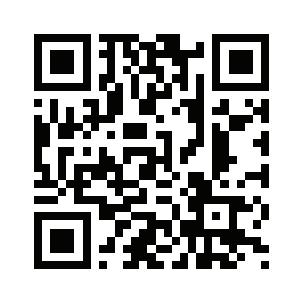
When we order numbers from smallest to largest, it is called the ascending order. For example,
The numbers 2, 12, 32, and 42 are in ascending order because 2 is the smallest number and 42 is the largest number here.
When we order numbers from largest to smallest, it is called the descending order. For example,
The numbers 50, 45, 40, 35, and 30 are in descending order because 50 is the largest number and 30 is the smallest number here.
Comparing numbers means deciding which number is greater, which number is smaller, or if they are equal.
We use symbols like ‘>’ (greater than),
Word Zone
Comparing: Looking at two or more things to see how they are the same or different. go
‘<’ (smaller than), and ‘=’ (equal to) to compare numbers.
We also use words such as ‘more than’, ‘less than’, and ‘equal to’ for this.
Look at the numbers 24 and 42. Both have the same digits, 2 and 4.
Which is greater: 24 or 42? ______
Here, 42 is more than 24, because 4 tens, i.e. 40, is more than 2 tens, i.e. 20.
40 > 20. So, we can say that 42 > 24.
For example,
If Aayu has 20 bananas and Pihu has 35 bananas, then Pihu has more bananas than Aayu because 35 is greater than 20 [35 > 20].
2. If Chinu has 22 candies and Mintu also has 22 candies. Then, both have the same number of candies, because 22 is equal to 22 [22 = 22].
1.
2.
3. Put the correct sign (<, >, or =) in the given boxes.
a. 12 8
b. 25 30
c. 15 15
d. 7 + 5 9 + 3
e. 18 - 5 14 + 2
4. Look at the numbers 23 and 32. Which is greater? __________
Backward counting means counting from the greatest to the smallest number. Forward counting means counting from the smallest to the greatest number.
On a number line, numbers are smaller on the left and greater on the right.
To compare numbers, we use '>' (greater than), '<' (less than), and '=' (equal to) signs.
There are two ways of organising numbers: ascending (from small to big) and descending (from big to small).
Pihu's grandmother gave her these coins and notes. Pihu arranged them as given below. Look at the statements and tick the correct answers.
a. The values of the coins are in decreasing order. (Yes/No)



b. The values of the notes are in ascending order. (Yes/No)



English:
Just like numbers, letters can also be arranged in an order. It is called the alphabetical order. Based on which letters come before and which ones come after, arrange the letters a, d, g, h, and j in the alphabetical order.
Arts:
Connect the dots from 1 to 50 to find the hidden picture. Colour the picture.
Create a group with 5 students randomly. Ask each student for their roll number and organise them in ascending order by writing their names and roll numbers in the table given below.
Roman numerals are special symbols used to represent numbers. Here are the Roman numerals from 1 to 10:
1 = I2 = II3 = III4 = IV5 = V
6 = VI7 = VII8 = VIII9 = IX10 = X
Engage your child in counting and arranging objects in and around the house, such as counting pebbles, arranging the pebbles in the ascending order of their sizes, and so on.
My Study Plan
• Counting numbers 51 to 99
• Numbers in numerals and words (51 to 99)
• Representation of numbers on abacus (51 to 99)
• Comparing numbers (greater, smaller, equal to)
• Ordering numbers (ascending and descending order)
Let’s Recall
Look at this sugarcane market.






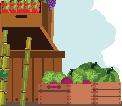


If represents 10 sugarcanes, then how many sugarcanes does each shop have? Shop 1:

What is the largest and smallest number you can create using the digits ‘2’ and ‘3’? Are both numbers the same?



Count the number of sticks and fill in the blanks. The first two have been done for you.
51 to 59 Let’s Learn


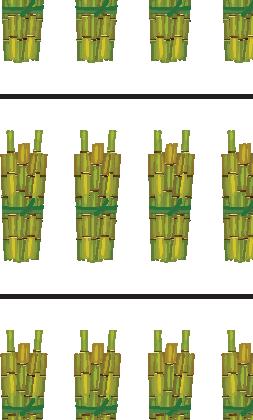















and ones
and ones
and ones



















8 tens and 0 ones
8 tens and 1 ones
8 tens and 2 ones
tens and ones
tens and ones 84 Eighty-four
tens and ones 85 Eighty-five







tens and ones 86 Eighty-six
tens and ones
Eighty-seven
tens and ones 88 Eighty-eight
tens and ones
Eighty-nine
and ones
Ninety-four tens and ones
Ninety-five tens and ones
and ones
and ones
1. Count the objects. Write the number and the number name for the given objects in each row.









Each bundle = 10 items


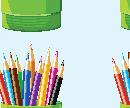

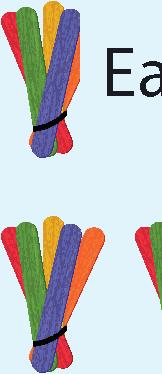
Each bundle = 5 items

Numbers on an abacus are shown by placing small objects, often beads, on a series of spikes. Each rod is for a place value such as ones, tens, etc. By moving the beads on these rods, we get the ones and tens place value of a number.
For Example: To represent the number 47, 4 red beads for the ‘tens’ position and 7 green beads for the ‘ones’ position are placed.





The abacus is one of the oldest calculating tools in the world.
Let’s Practise -2
1. Write the number shown on the abacus.
Number

Numbers that can be read the same forwards and backwards are called palindromes. For example, numbers like 11, 22, and 33 are the same when read in reverse.
Let’s Learn
Comparison of numbers means looking at two or more numbers and deciding which one is bigger, smaller, or if they are the same. We use symbols like ‘>’ (greater than), ‘<’ (less than), or ‘=’ (equal to) to compare numbers.
For example, 56 < 67 (56 is lesser than 67)
78 > 43 (78 is greater than 43)
Let us understand how to compare numbers using an example. We have two blocks. One block has 6 written on it and the other has 3 written on it. Let us try to make a two-digit number using these blocks. We can make two numbers using these blocks.
36 and 63.
36, has 3 tens and 6 ones. 63, has 6 tens and 3 ones.
Who made a larger number: Aayu or Pihu?
Here, the number with the larger tens is larger. So we can say that 63 > 36.
When we arrange numbers from smallest to largest, it is known as ascending order.
For example, 61, 62, 63, 64, 65, 66, 67, 68, 69.
When we arrange numbers from largest to smallest, it is known as descending order.
For example, 99, 98, 97, 96, 95, 94, 93, 92, 91.
Let’s understand this better by arranging the numbers 43, 58, 82, 48, 77 in ascending and descending order.
Step 1:
Compare the digits in the tens place.
Among the given numbers, we can see that the largest digit at the tens place is 8. So, the number 82 is the largest.
Then comes 77, which is larger than 43, 58, and 48.
Next, 58 is larger than 43 and 48.
Step 2:
Compare the digits in the ones place.
On comparing 43 and 48, we can say that 43 is the smaller number.
So, the ascending order of the given numbers is 43, 48, 58, 77, 82.
And, the descending order of the given numbers is 82, 77, 58, 48, and 43.
1. Compare the following numbers by choosing the correct sign among <, > , and =.
a. 67 79
b. 72 58
c. 82 82
d. 98 89
2. Arrange the following numbers 57, 63, 50, 82, 73 in
a. Ascending Order
b. Descending Order
3. Compare tens and ones to find out which number is greater and which number is smaller.
a. 54 and 91
Bigger number
b. 88 and 82
Bigger number
Smaller number
Smaller number
• Numbers on an abacus are shown by placing small objects, often beads on a series of spikes. Each rod is for a place value such as ones and tens.
• Comparison of numbers means deciding if one number is ‘>’ (greater than), ‘<’ (less than), or ‘=’ (equal to) the other number.
• Ascending order means arranging numbers from smallest to largest.
• Descending order means arranging numbers from largest to smallest.
An orange tree gives around 80-90 oranges; and a banana tree gives around 50-60 bananas. Which tree gives more fruit?
Imagine you have 30 marbles. Among your friends, Liam has 68 marbles, Zoe has 77 marbles, Noah has 100 marbles, and Olivia has 10 marbles. Arrange the number of marbles from the largest to the smallest to see who has more and who has fewer marbles.



Count the cars that drive by your house in one day. Will it harm the environment? If yes, what are the ways to stop it? Discuss with your elders and teachers.










60 minutes = 1 hour
An hour is a big piece of time, and it has 60 minutes inside it. Each minute is like a small part of that big piece. And guess what? Each of those minutes has 60 tiny parts called seconds. That’s how we measure time, with 60 minutes in an hour and 60 seconds in each minute!
• Encourage mental math calculations with numbers in this range.
• Engage in hands-on activities like counting objects, creating number lines, or using an abacus to visualize numbers and their relationships.
My Study Plan
Addition up to 99 by forward counting
Addition up to 99 by grouping
Addition up to 99 using column method
Addition using abacus
Let’s Recall
A girl loves to collect soft toys. Let’s see what she has in her box!



She has 11 teddy bears and 5 stuffed toy dogs. She has_______ toys in total.
Thinking Zone
Which of these is easier to calculate?
a. 10 + 10 + 3

b. 10 + 13
Addition is the process of combining two or more numbers to find their total.
For example, if you have 3 apples and you want to add 4 more, count forward 4 more times after 3, as shown below:
So, 3 + 4 equals 7 apples in total.
Addition by forward counting means you start with one number and count forward, adding one at a time until you reach the total.
Let us take another example:
Pihu has 15 candies, and Aayu gives her 4 more candies. To find out how many candies Pihu has now, just start with 15 and count 4 more: 16, 17, 18, 19.































So, Pihu has 19 candies now.













Let us take one more example to understand forward counting: Add 20 + 5 by counting forward.
To find the sum, start from 20. Count forward 5 times by adding 1 at a time.
21, 22, 23, 24, 25
Hence, 20 + 5 = 25.
Let’s Practise - 1
1. Add the following by counting forward. One has been done for you.
a. 53 + 4 54 55 56 57 = 57
b. 34 + 5 = c. 43 + 2 =
3
Let’s Learn
Addition by grouping of 10 means adding numbers by grouping them together in sets of 10.
For example, 10 pencils can be written as a group of 1 ten.
Word Zone
Grouping: Putting things together








Zero (0) is the only number that, when added to any other number, gives the same number.
For example, 5 + 0 = 5.

Let us look at examples of addition by grouping:
Example 1:
Add 15 pineapples and 14 pineapples together.






























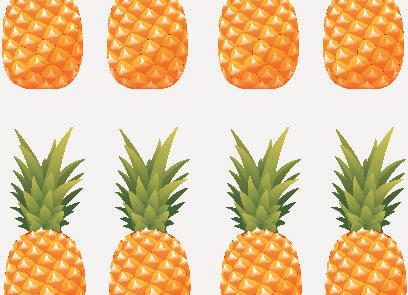











Solution:



























Let us learn the addition of these pineapples step by step:
Step 1: Break the numbers 15 and 14 into tens and ones.







































15 = 10 + 5 and 14 = 10 + 4
15 = 1 ten + 5 ones and 14 = 1 ten + 4 ones
Step 2: Now add ones together.
5 ones + 4 ones = 9 ones









Step 3: Next, add tens together.
1 ten + 1 ten = 2 tens


























2 tens + 9 ones = 29















Putting tens and ones together:
So, we have 29 pineapples in total.
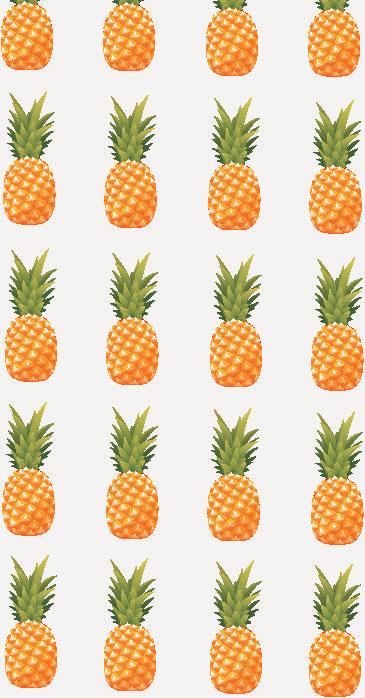
Example 2:
Rahul has collected 13 leaves and Amit has 8 leaves. Let us find the total number of leaves they have altogether.
Solution:
Step 1: Break the numbers 13 and 8 into tens and ones.
Step 2: Now add ones together. 3 ones + 8 ones = 11 ones 13 leaves 8 leaves
13 = 10 + 3 and 8 = 8 13 = 1 ten + 3 ones and 8 = 0 tens + 8 ones
We can further regroup 11 ones into 1 ten and 1 one.
11 = 10 + 1
So, 11 ones = 1 ten + 1 one
Step 3: Next, we add the tens.
1 ten + 1 ten = 2 tens
Putting tens and ones together:
2 tens + 1 one = 21
So, Rahul and Amit have 21 leaves altogether.
Let’s Practise - 2
1. Add blue and red butterflies to find the total.
Total = ________________________.
2. Add both types of leaves to find the total.
Total = ________________________.

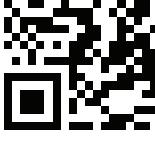
To add numbers quickly, we can write them one below the other and add them. This is called the column method or vertical addition.
Let’s solve the addition problem given below.
Example 1: Add 25 and 4.
Solution: 25 + 4 = ______
Step 1: Arrange the digits of the given numbers in tens and ones column as shown below.
Step 2: Add the digits in the ones place (rightmost column) of both the numbers.
A straight line of things
Step 3: Add the digits in the tens place of both the numbers.
Therefore, 25 + 4 = 29.
Example 2: Add 31 and 24.
Solution: 31 + 24 = ______
Step 1: Arrange the digits of the given numbers in tens and ones column as shown below.
Step 2: Add the digits in the ones place (rightmost column) of both the numbers.
Step 3: Add the digits in the tens place of both the numbers.
Therefore, 31 + 24 = 55.
When the total of the numbers in ones column is greater than nine, we regroup the total into tens and ones and move the excess number to the next column on the left.
Let’s solve the addition problem given below with regrouping.
Example 1: Add 56 and 39.
Solution: 56 + 39 = ______
Step 1: Arrange the digits of the given numbers in tens and ones column as shown below.
Step 2: Add the digits in ones place. So, 9 + 6 = 15.
Since 15 ones is more than 9, we regroup 15 as 1 ten and 5 ones. Write 5 under the ones column and carry over 1 to the tens place.
Step 3: Add the digits in the tens place.
Therefore, 56 + 39 = 95.
Abacus is an ancient counting tool that people used long ago to do math.
Abacus has these rows of beads that show different place values.
Each row represents a different place value, like ones, tens, hundreds, and so on.
For example, imagine you want to add the numbers 8 and 3 using an abacus.
Let us start with 8 beads in the ones column.
In the ones column, we can see that there are 8 beads and we need to add 3 more to it.
Once we add the 3 beads, we will see that there are 11 beads in the ones column, which means 10 beads and one more. Now, let us add 1 bead in the tens column to show the group of 10 beads in ones column. The ones column will be left with one bead.
Finally, we see that we get 8 + 3 = 11, as we have one bead in the tens column and one bead in the ones column.
Let’s Practise - 3
1. Add the following without regrouping. a. b.
2. Add the following with regrouping. a. b.
Addition by forward counting means we start with one number and count forward, adding one at a time until we reach the total.
Addition by grouping of 10 means adding numbers by grouping them together in sets of 10.
To add numbers quickly, we can write them one below the other and add them. This is called the column method or vertical addition.
We can also add numbers using an abacus. Abacus is a very old way of adding numbers. It has beads in different columns to show different place values.
During Diwali, Pihu lit 24 diyas on the terrace and 15 diyas on the balcony. How many diyas did Pihu light in total to celebrate Diwali?
Cross-Curricular Connections
Aayu is travelling from Mumbai to Pune via Lonavala. The distance from Mumbai to Lonavala is 83 kms and the distance from Lonava to Pune is 65 kms. What is the total distance that Aayu is travelling?
Count how many boys and girls are there in your class.
Number of boys =
Number of girls =
Then, add them to know the total number of students in your class.
Total number of students in class =
When we add two numbers, the result stays the same no matter in what order the numbers are written.
For example: 32 + 45 or 45 + 32
Hence,
45 + 32 = 77
32 + 45 = 77
Create real-life addition problems using everyday situations.
My Study Plan
• Subtracting 1-digit and 2-digit numbers from 2-digit numbers
• Subtraction using counting backwards
• Subtraction using abacus
• Subtraction using striking out method
• Subtraction using column method
• Subtraction for comparison of numbers
1. 9 birds were sitting on a tree. Later, 4 birds flew away from the tree. Find out how many birds are still on the tree.
So, the remaining birds on tree are _____.
2. Read the abacus and write the number.


Sara has two baskets of apples. Can you find out which basket has more apples? If you want to have equal number of apples in both the baskets, from which basket will you take apples, and how many will you take?
1. Basket ____ has more number of apples.
2. ______ apples should be taken from _____ basket to have equal number of apples in both the baskets.
Subtraction is taking away a smaller number from a bigger number. We have already learned how to subtract smaller numbers. Now, we will explore subtracting bigger numbers, up to 99, in this chapter.
Let us learn different methods of subtraction.
We can subtract numbers by counting backwards. Let us learn using some examples.

Word Zone
Backward: Directed behind or reverse
Example 1: Aayu stands at number 39 as shown below. If he jumps back 6 numbers, which number will he land on?
Solution:
Using the backward counting method, we will count 6 numbers backwards from 39.
So, Aayu will land on 39 - 6 = 33 number.
Example 2: Pihu has 28 pineapples. Pihu gives away 5 pineapples to her friends. How many pineapples are left with Pihu?
Solution:
Using the backward counting method, we will count 5 numbers backwards from 28.
So, 28 pineapples – 5 pineapples = 23 pineapples.
Aayu has 35 candies in a jar, and he eats 4 candies. How many candies are left in the jar?
Solution:
Using the backward counting method, we will count 4 numbers backwards from 35.
So, 35 candies – 4 candies = _____candies.
1. Subtract the following by counting backwards. One is done for you.
Counting backwards can be used when we subtract one-digit numbers from two-digit numbers.
But it is difficult to count backwards when we have to subtract twodigit numbers. In this case, we will use striking out method. Let us look at an example.
Example 1: Subtract 25 from 48.
Solution:
Step 1: Draw lines to indicate digits in the tens place and dots to indicate digits in the ones place. Here, we will draw 4 lines and 8 dots for number 48.
Step 2: Strike out the lines and dots that we need to subtract. Here we will strike 5 dots from the ones place and 2 lines from the tens place.
Step 3: Count the remaining lines and dots and write the answer.
Here, 2 lines and 3 dots are remaining. So, the answer is 23.
Hence, 48 - 25 = 23.
Example 2:
There are 52 footballs in the society club. 11 footballs are damaged. How many footballs are left in the society club?
Solution:
The number of footballs in the society = 52
The number of footballs that are damaged = 11
Footballs that are left in the society club = 52 - 11
Step 1: Draw lines to indicate digits in the tens place and dots to indicate digits in the ones place. Here, we will draw 5 lines and 2 dots for the number 52.
Step 2: Strike out the lines and dots that we need to subtract. Here we will strike 1 dot from the ones place and 1 line from the tens place.
Step 3: Count the remaining lines and dots and write the answer.
Here, 4 lines and 1 dot are remaining. So, the answer is 41.
Hence, 52 - 11 = 41.
Let’s Practise - 2
1. Subtract using striking out method.
a. Subtract 26 from 87
b. Subtract 14 from 38
2 There are 42 roses in the garden. Aayu plucked 21 roses from the garden. How many roses are now left in the garden?
We can also subtract numbers using an abacus.
Let us look at this example.
Example 1: Subtract 32 from 65.
Solution:
Step 1: Draw the beads in tens rod and in ones rod.
Here, we will draw 6 beads in the tens rod and 5 beads in the ones rod.
Step 2: Remove the beads that we need to subtract from the respective rods.
Here, we have to subtract 32 from 65.
So, we will cancel 2 beads from ones rod and 3 beads from tens rod.
Step 3: Count the remaining beads in both the rods and write the answer.
Here, we have 3 beads in the tens rod and 3 beads in the ones rod.
So, the answer is 33.
Hence, 65 – 32 = 33.
Let’s Practise - 3
1. Subtract using abacus method.
a. 54 – 12
b. 73 – 21
c. 85 – 34
Let’s Learn
To subtract numbers quickly, we can write them one below the other and subtract them. This is called the column method or vertical subtraction.
Let’s solve the subtraction problem given below.
Example 1: Subtract 3 from 16.
Solution: 16 - 3 = ______

Step 1: Arrange the digits of the given numbers in tens and ones column as shown.
Remember, the greater number must be written above the smaller number.
Here, 16 > 3.
Step 2: Subtract the digits in the ones place (rightmost column) of both the numbers. Here, 6 ones - 3 ones = 3 ones.
Step 3: Next, subtract the digits in the tens place of both the numbers.
Here, 1 ten - 0 ten = 1 ten.
Therefore, 16 - 3 = 13.
Example 2: Subtract 25 from 38.
Solution:
38 - 25 = ______
Step 1: Arrange the digits of the given numbers in tens and ones column as shown below.
Remember, the greater number must be written above the smaller number.
Here, 38 > 25
Step 2: Subtract the digits in the ones place (rightmost column) of both the numbers. Here, 8 ones - 5 ones = 3 ones.
Step 3: Next, subtract the digits in the tens place of both the numbers.
Here, 3 tens - 2 tens = 1 ten. Therefore, 38 - 25 = 13.
Example 3: A library had 89 books on a shelf. If 57 books were borrowed by students, how many books would be left on the shelf?
Solution:
Number of books on the shelf = 89
Number of books students borrowed = 57
Books left on the shelf = 89 – 57
Hence, 32 books would be left on the shelf.
Example 4: An amusement park had 78 tickets for the roller coaster ride. If 47 tickets were sold, how many tickets are left?
Solution:
Number of tickets for the roller coaster = 78
Number of tickets sold = 47
Number of tickets left = 78 – 47
Hence, 31 tickets were left.
Let’s Practise - 4
1. Subtract the following.
Let’s Learn
There are 9 green and 5 orange fishes.
Which type of fish are less or more in number? 1 2 3 4
Here, green fish (9) are more in number than orange fish (5). 9 – 5 = 4
So, green fish are 4 more than orange fish.
Or, we can say orange fish are 4 less than green fish.
Let us take another example.
Example:
Aayu has 13 pencils, and Pihu has 7 pencils.

Find out who has more and who has fewer pencils, and how many more or fewer pencils they have.
Solution:

Here, Aayu has more pencils than Pihu.
Then, 13 – 7 = 6
So, Aayu has 6 more pencils than Pihu.
Or we can also say that Pihu has 6 fewer pencils than Aayu.
Fewer: A small number of things or people Word Zone
Let’s Practise - 5
a. Plant A has 15 leaves, and Plant B has 9 leaves. Find out which plant has fewer leaves and how many fewer leaves it has.
b. Amit has 23 pebbles, and Aman has 14 pebbles. Who has more pebbles, and how many more pebbles do they have?
Subtraction is taking away a smaller number from a bigger number.
Subtraction can be carried out in different ways like subtraction by backward counting, subtraction by striking out method, subtraction using an abacus, subtraction using column method, and subtraction by comparison of numbers.
Ritu has 45 cookies, and she wants to share them with her friends. If she gives 20 cookies to one friend and 15 cookies to another friend, how many cookies are left for her?
In the history class, you learnt about a king who had 80 gold coins. He spent 42 gold coins to build a castle. How many gold coins are left with the king?
Work together with your partner to solve this question.
78 - A
To find ‘A’, look for a number where the ones digit represents the number of wheels on a car, and the tens digit represents the number of ears you have.
A number bond is a picture that shows a number and its parts. The largest number is in the topmost circle, and lines are connect to the smaller numbers. If we want to find the missing number, we can take away, or subtract. Let us look at an example,
Here, the largest number is 67 and the smaller number is 7. We can find the other number by subtracting 7 from 67. 67 – 7 = 60.
Solve a few more on your own. It’s fun Math!
Create real-life scenarios for subtraction, such as sharing toys, counting change, or figuring out how much is left after using items.
Arrange games and activities that make subtraction enjoyable. Board games, math apps, or flashcards can be engaging tools.
My Study Plan
• Length and height
• Measurement of length
• Weight
• Measuring weight
• Comparing capacities
• Measuring capacities
Let’s Recall
Colour the bigger animal pink and smaller animal yellow.
Colour the taller flag red and shorter flag blue.
Aayu has a toy car and a toy train. The toy car is shorter than the toy train.
Can you find a similar pair of long and short objects in you classroom? Draw a picture of them.
Things are available in different shapes and sizes. We can tell the difference between them by using different measurement terms like length, height, weight, and capacity. Let us learn each of them in detail.
Length is how long or short something is. For comparing lengths, words like long and short are used.
The word ‘longest’ is used for the thing which has maximum length and the word ‘shortest’ is used for the thing which has minimum length.
Sometimes, we may want to know how long an object is. For this, we measure the length of the object.
We can measure the length of an object by using our body parts. For example, hand span, cubit, foot span, and stride.
The wooden stick is 4 hand spans long.
The carpet is 4 foot spans long. Hand spanFoot spanStride Cubit
We can also measure the length of an object by using objects such as pencils and crayons.
For example,
The wooden table is 4 pencils long.

Length and height can also be measured by using rulers and tape measures or by comparing one thing to another.
Let’s Practise - 1
1. Look at the pictures and answer the questions.
a. The pencil is__________ crayons long.

b. The pencil box is__________ crayons long.

c. Which building is the shortest? __________
2. Number the objects from the shortest to the longest.
Weight
Weight is how heavy or light an object is.

The word ‘heaviest’ is used for the thing which has maximum weight and the word ‘lightest’ is used for the thing which has minimum weight.

































Fact Zone
Giraffes are the tallest animals on Earth. They can grow up to 18 feet tall, which is as tall as a two-storey house.
We can use different objects such as stones, pebbles, bricks, and sandbags to measure the weight of an item.











Fact Zone
The blue whale is the heaviest animal on Earth, while some of the lightest animals are butterflies.

1. Write H for the heaviest and L for the lightest ones:
2. How heavy is the object?
3. Fill in the blanks























The water bottle weighs The weight of mango is about about ____ balls. ______ balls.
a. The order of animals from the lightest to the heaviest is _______, _______, _______.
b. The order of objects from the heaviest to the lightest is _______, ________, _______.
Capacity of a container is the amount of liquid it can hold
For example, various containers such as cups, glasses, bottles, and jars have different sizes and different capacities.












































For comparing capacities, words such as more and less are used.
For example, a big jug can hold more water than a small cup.



















We can use different vessels such as glass, mug, and cup to measure the capacity of a vessel.
For example,

















The capacity of the bottle is 3 cups.

The capacity of the bucket is 11 cups.
1. Pihu pours water from the jug into the glasses. She could fill 4 glasses with water. Now, let us answer some questions.

a) The jug can hold ________ glasses of water.
b) The jug has ______ capacity (more/less) than each glass. Let’s Practise - 3
2. Colour the vessels based on their capacities from less capacity to more capacity. The order of colour will be red, green, blue and yellow.
Ice cream cones come in different sizes and that affects how much ice cream you can have. A big cone holds more ice cream than a small one.
Objects come in various shapes and sizes, and we use measurement terms such as length, height, weight, and capacity to differentiate them.
Length means how long or short an object is, and we use terms like ‘long’ and ‘short.’ ‘Longest’ and ‘shortest’ denote maximum and minimum lengths, respectively.
Length can be measured using body parts like hand span, cubit, foot span, and stride. Objects like pencils or rulers can also be used for measurement.
Weight means how heavy or light an object is. ‘Heaviest’ and ‘lightest’ describe maximum and minimum weights. Various objects like stones can be used for weight measurement.
Capacity refers to the amount of liquid a container can hold. ‘More’ and ‘less’ are used for comparing capacities. Different vessels like glasses or cups can be used to measure capacity.
Riya and Rashi study in class 1. Riya is carrying a pumpkin in a polybag, and Rashi is carrying 2 oranges in a polybag. Who will get tired sooner? Why?
For this activity, students will have to work in pairs.
Step 1: One of the students will mark the cubit distance (distance from elbow to the top of the longest finger) of his/her friend on a ribbon and write the friend’s name. Then, measure the length of the ribbon between the marks with the help of crayons.
Step 2: The second student will also follow the same steps.
Step 3: Compare the lengths of both ribbons by counting crayons and see whose ribbon is longer.
Let’s explore our living spaces! Use your feet to measure the length of your living room and record the number of foot spans in your notebook. Ask a family member to do the same and write down their answer, too. Afterwards, compare the two numbers and think about why they might be the same or different.
Explore the kitchen with curiosity! Work alongside your mom and observe how she measures ingredients for cooking. List at least 3 tools she uses to measure things like flour, sugar, or liquids. How do these tools help her ensure that the recipe turns out just right? Share your findings and think about how measuring in the kitchen connects to what we’ve learned about measurement in class.
Encourage your child to measure everyday objects like spoons, shoes, or stuffed animals. This makes learning about measurement practical and relatable.
Engage with your child about words like ‘longer’, ‘shorter’, ‘heavier’, and ‘lighter’ in everyday conversations to describe objects and their sizes.
My Study Plan
• Day time and night time
• Order of events in a day
• Short and long duration events
• Days of the week
• Yesterday, today, and tomorrow
• Months of the year
• Time on a clock
• Time in words and numbers
Tick(��)alltheactivitiesyoudointhemorning.
Look at the pictures. Tick (��) the time of the day when you should go out to play.





Let’s Learn
Day Time and Night Time
There are two periods of time:
Day Time
Day time is when the sun is up in the sky. It becomes bright outside.

Night Time
Night time is when the moon and stars are in the sky. It becomes dark outside.


All the activities that we do during a day follow an order from morning till night.
Go to Sleep
1. Look at the pictures. Number the activities to show the order from morning to night. One has been done for you. Let’s Practise - 1

Tick the correct option.
a. We have lunch in the (Morning/Afternoon/Evening/Night).
b. We wake up in the (Morning/Afternoon/Evening/Night).
c. We go to sleep at (Morning/Afternoon/Evening/Night).
d. We have our dinner at (Morning/Afternoon/Evening/ Night).
Short events
Events that require less time to finish are called short-duration events.
For example:
Long events
Events that require more time to finish are called long-duration events.
For example:
In old times, Romans used a calendar of 10 months. In their calendar, the months were named Martius, Aprilis, Maius, Junius, Quintilis, Sextilis, September, October, November, and December.
A week has seven days. A week starts on a Monday and ends on a Sunday. Read the names of the days of the week in the correct order.
Today is the day we are living right now.
On a Sunday, we say ‘today is Sunday’.
Yesterday means the day before today.
On a Sunday, we say ‘Yesterday was Saturday’. Tomorrow means the day that will come after today.
On a Sunday, we say ‘tomorrow will be Monday’. Yesterday was.. Today is... Tomorrow will be...

Let’s Practise - 2
1. Fill in the blanks.
Which day comes between?
a.Tuesday Thursday
b.Monday Wednesday
c.Sunday Tuesday
d.Wednesday Friday
e.Friday Sunday
2. Fill in the blanks.
a. What day is it today ?__________________________________
i. Name a few activities that you are doing today. _____________________________________________________
b. What day was yesterday? ______________________________
ii. Name a few activities that you did yesterday. ____________________________________________________
c. What day will tomorrow be? ___________________________
iii. Name a few activities that you will do tomorrow. _________________________________________________
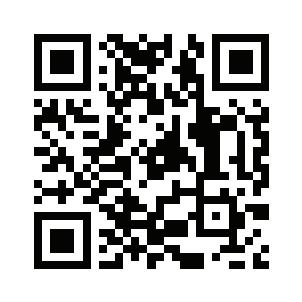
To measure long periods of time, we use days, weeks, months, and years.
There are 12 months in a year. Each month has its own name. January is the first month of the year. December is the last month of the year.
Let’s Practise - 3
1.Fill in the blanks.
Who am I?
a. I am ______. I am the first month of the year.
b. I am ______. I am the third month of the year.
c. I am ______. I am the sixth month of the year.
d. I am ______. I am the last month of the year.
2. Eating dinner is a _____ (long/short) duration event.
3. Summer vacation is a _____ (long/short) duration event.
A clock helps us know what time it is. When you look at a clock, you see numbers from 1 to 12. There are two hands on the clock. One hand is for hours and the other hand is for minutes. The longer needle is the minute hand and the shorter needle is the hour hand.
Time in words and numbers
Telling the time in words
Look at the clock with numbers.
When the hour hand points at 6 and the minute hand points at 12, we say it is ‘six o’clock’.
When the hour hand points at 3 and the minute hand points at 12, we say it is ‘three o’clock’.
We do this for all the hours on the clock.
While using numbers, instead of saying ‘six o’clock,’ we write ‘6:00’. The first number is for the hour, and the second number is for the minutes.
When the hour hand is on 3 and the minute hand is on 12, we write ‘3:00’.
Let’s Practise - 4
1. Draw the hour hand to show the following time. One has been done for you.
7:008:009:0010:0011:00
2. Write the time as shown by the clocks in words and numbers. One has been done for you.
Twoo’clock 2:00
Instead: In the place of Word Zone
• There are two periods of time — Day Time and Night Time.
• All the activities that we do during a day follow an order from morning till night.
• Events that require less time to finish are called short duration events.
• Events that require more time to finish are called long duration events.
• A week has seven days.
• There are 12 months in a year. Each month has its own name.
• Today is the day we are living right now.
• Yesterday means the day before today.
• Tomorrow means the day that will come after today.
• In a clock, we have numbers 1 to 12. There are two hands on the clock; the short hand is for hours and the long hand is for minutes.
How do you plan your day to make sure you have enough time for schoolwork, play, and chores?
Life Skills Science:
Name three animals that are most active during the day and three animals that are active at night. Cross-Curricular Connections
Suppose you are in charge of making sure that everyone in your family is ready for an outing at 10:00 in the morning. How will you do that?
Each month has different number of days. We can use our knuckles to remember the number of days in a month.

Start with your leftmost knuckle (January). Every hill (knuckle) has 31 days. Every valley (space between the knuckles) has 30 days. Only February has 28 or 29 days. When you reach the rightmost knuckle (July), go back to the leftmost knuckle (August).
• Ask your child questions like, “What time is it?” and “What day is it today?” to reinforce their learning.
• Play games that involve time and calendars such as setting a timer for a fun activity or playing calendar-related board games.
My Study Plan
• Indian currency (notes and coins) and rupee symbol
• Addition of notes and coins separately
• Addition of combination of notes and coins
• Estimation of prices
Let’s Recall
Pihu went to the fruit shop to buy fruits.



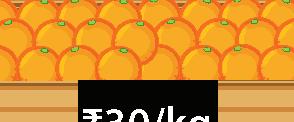
Look at the picture above and answer the following questions:
1. What is the price of watermelons? ______
2. What is the price of mangoes? ______
3. What is the price of oranges?______
4. What is the price of apples?_______
Thinking Zone

In the past, how do you think people used to buy things when money was not in use? Discuss with your classmates.
Money is used to buy and sell things.
In India, money is used as rupee and paise. The symbol for a rupee is ₹, and for paise, it is “p”.
Money can be in the form of coins or notes.
Coins
Coins are little, round metal pieces. A coin has two sides.

The side of the coin showing the emblem is the head side.
The other side of the coin is called the tail side.

These are the different coins used in India. ₹20 coins are rarely used.
Word Zone
Symbol: A special picture or sign that represents something
Metal: Hard and shiny object
Emblem: A pillar that consists of four lions standing back to back

1 Rupee (₹1)


Rupees (₹20)

2 Rupees (₹2)5 Rupees (₹5)

Rupees (₹10)
Notes
Notes are like paper, and they show numbers to tell us their value.






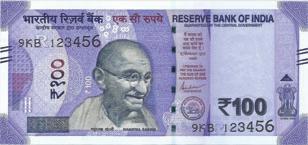
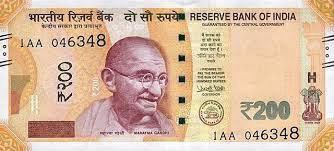

Look at this special ₹ symbol. It was made by D. Udaya Kumar. He mixed the English letter “R” and the Hindi letter “₹ ” (ra) to create it. His design was selected through a public competition.




1. Write the value of each coin and note in the blank space. Remember to add the symbol.









Counting money means counting coins and notes. To count money, we look at each coin and note. Each one has a number on it. We add those numbers to see how much money we have. Let us look at the money the kids in the picture have with them: The girl has two notes of 10 rupees. She has 10 + 10 = 20 rupees in all. The boy has one note of 20 rupees. So, both have the same amount of money.





Let us look at another example. Rinku’s father bought him a new piggy bank. Rinku has these coins to put inside the piggy bank.








The total amount = ₹1 + ₹1 + ₹1 + ₹1 + ₹1 + ₹2 + ₹2 + ₹2 = ₹11
So, Rinku has a total of ₹11 in his piggy bank.
Fact Zone
We use ‘rupees’ when we have more than one rupee.
Let’s Practise - 2


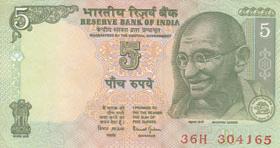
1. Match the following by drawing a line. ₹30 ₹8 ₹25 ₹4












Let’s Learn How to Pay?


When you buy something, you give money. This money can be different coins or notes. You put them together to pay.
For example, if you have one 10-rupee note and two 5-rupee notes, you have 10 + 5 + 5, which is ₹20.


+ = ₹20

If you also have three 1-rupee coins and two 2-rupee coins, you add those as well. So, 1 + 1 + 1 + 2 + 2 , which is ₹7.





So in total, you have ₹20 + ₹7 = ₹27.
Let us say Alia wants to buy an ice cream cone that costs ₹8. She checks her pocket and find two coins and a note: a 1-rupee coin, a 2-rupee coin, and a 5-rupee note.
To pay for the ice cream, Alia puts all these coins and notes together. It is: 1 + 2 + 5 = ₹8.


Word Zone
Buy: Get something you want by giving money for it
A coin or a note with the same number on it has the same value.


1. Count and write the amount. a. ++= b. + = Let’s Practise - 3








2. Look at the things given below and answer the questions.
Pencil 5 /unit
Pen 10 /unit
Notebook 17 /unit
Eraser 3 /unit
Sandwich 45 /unit

a. State which coin(s) or rupee(s) you can use to buy a pencil.
b. What combination of different notes and coins can be used to buy a notebook?
c. What combination of different notes and coins can be used to buy a sandwich?

When Pihu is at a store and wants to buy something, she tries to guess how much it might cost.
For example, if she wants a toy, she might guess it costs ₹50. If she wants some yummy cookies, she might guess they cost ₹20.
Look at this eraser and this bag. Can you guess the prices of both things? Will the price of the eraser be more or less than the price of the bag?
We can see and understand that the eraser is small and simple, but the bag is big with many sections and pockets. So, this can help us guess that the price of the eraser will be less than that of the bag.
Let’s Practise - 4
1. Guess the price and write in the space provided below.





Store:
Guess: Try to figure out what or how many


Money is used to buy and sell things.
In India, money is in the form of rupee and paise. The symbol of rupee is , and that of paise is “p”.
There are different coins and notes used in India.
We can count money by looking at the numbers on the coins and notes and adding them.
To make a payment, we need to put together the money we have, and pay as per the price of the thing we want to buy.
Imagine that you have 30. Write down the names of three things you could buy with this money.
Coins and paper money are made from special materials. Can you think of some materials that might be used to make coins and paper money, and why do you think these materials are chosen?
Social Studies:
In our community, people do different types of jobs to earn money. Can you think of a few jobs which people do? Do they all earn an equal amount of money, or do some earn less and some earn more? Cross-Curricular
Your parents buy lots of things online. Ask them how they make payments for the things they buy online. Discuss with your friends.
Imagine Aman has 50 and Kanika has 35, and we want to find out how much more money Aman has than Kanika. To do that, we need to subtract 50 from 35. We get 50 - 35 = 15. So, Aman has 15 more than Kanika.
Teach the concept of saving with a piggy bank, motivating your child to save a small amount regularly.
My Study Plan
• Sorting objects
• Collecting and representing data
• Interpreting visual representations
Let’s Recall
Look at the different fruits given in the picture.
Count and write the number of each fruit below:

Think about how your parents sort and keep vegetables and fruits at home. Do they keep all the fruits and vegetables together in the fridge or separately? Why do they do that? Discuss with your friends.

Sorting things means putting similar things together. When we sort things, we put them in groups with other things that are the same or similar.
For example: Putting all car toys together, all truck toys together, all soft toys together, and all balls together. Arranging things in this way makes it easier to find and play with toys.




Sorting helps to recognise that things can be the same or different as they belong to certain groups.
1. Draw lines to match the flowers with the correct flower baskets.







Word Zone
Gathering: Bringing things together



































































Collecting data means gathering information. Sorting data means putting similar things together. And representing data means showing it clearly.

Let us understand this with an example. Imagine you have a box of different coloured candies and want to give them to your friends. So, you ask your friends about their favourite candy colour.
Let us count the candies based on the colour and represent the data clearly in the form of a chart.
candies
candies
Green candies
candies
candies
Now that you know how many candies you have of each colour, it will be easy for you to give them to your friends. Just look at the colour they like and the number of candies you have.
Just like storybooks have pictures to tell a story, we can use pictures to tell a story about information. Fact Zone
Let’s Practise - 2
1. Count the number of each fruit and colour the same number of fruits in the table below.
Mangoes
Bananas
Cherries
Grapes



Why do you think presenting information using pictures is useful? Discuss with your classmates.
Making and reading data is like writing numbers or drawing pictures to show things, and then understanding what they mean. Let us understand this with the help of the chart given below







At school, the sports teacher wants to count how many balls of each kind they have, for all the different games.
• How many tennis balls are there?
How many cricket balls are there?
Which ball is most in number?
How many more soccer balls are there than rugby balls?
What is the total number of balls?
1. In a fruit shop, the fruit vendor is selling many different kinds of fruits.
Observe the information shown above and answer the following questions.
a. How many pineapples are there in the shop? ____________
b. Which two fruits are the same in number? ____________ and
c. Which fruit is the least in number? ___________________
d. Which fruit is the most in number? ___________________
Sorting things means putting similar things together.
Collecting means gathering information.
Representing data means showing the data clearly.
Making and reading data is like writing numbers or drawing pictures to show things, and then understanding what they mean.
Look at the chart of flowers Aayu and Pihu bought from the flower shop to gift their mother on her birthday.
Roses




































Observe the data and fill in the blanks:
























There are ____ lilies. Aayu likes the 5 __________ while Pihu likes the __________ carnations. The smell of the ____ roses is very good. Their mother likes the 8 ________________ the most.
Art
Look at the image below. How many squares, circles, rectangles and triangles can you find? Colour the image and have fun.
ShapeTotal Number
Squares
Circles
Rectangles
Triangles
Call 10 of your friends and ask them to choose their favourite flavour of ice cream from chocolate, strawberry, and vanilla.
Based on their answers, complete the following table:
Favourite ice cream
flavour
Name of your friends


Number of friends who like chocolate ice cream _____
Number of friends who like strawberry ice cream __
Which flavour of ice cream do most of your friends like?
There are different ways of showing data. One such way is tally marks. Tally marks are like a secret code that makes counting easier. Here, instead of writing numbers, we use lines or slashes. A tally mark is represented with the symbol “|”. For the first four counts, we draw one line for each. For the fifth count, we draw a line across the previous four lines.
Involve your child in real-life experiences such as sorting different fruits and vegetables, planning a party, measuring and recording their height, etc. This makes learning interactive and fun.